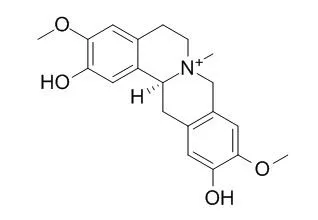| Description: |
Phellodendrine has the effect of suppressing cellular immune response, reducing blood pressure and antinephritis, it also has antioxidant, and anti-inflammatory effects. Phellodendrine can suppress local semisyngeneic GvH reactions and systemic allogeneic GvH reactions in X-ray irradiated recipient mice, it also can suppress the induction phase of sheep red blood cell (SRBC)-induced delayed type hypersensitivity in mice and tuberculin-induced delayed type hypersensitivity in guinea pigs, Phellodendrine can down-regulating AKT, IKK, NF-kB phosphorylation and COX-2 expression induced by AAPH, it also ameliorates the ROS-mediated inflammatory response.
|
| Targets: |
Akt | IkB | NF-kB | COX | ROS | IL Receptor | IKK |
| In vitro: |
| J Chromatogr B Analyt Technol Biomed Life Sci. 2016 Sep 1;1029-1030:95-101. | | Pharmacokinetic studies of phellodendrine in rat plasma and tissues after intravenous administration using ultra-high performance liquid chromatography-tandem mass spectrometry.[Pubmed: 27428451 ] | Phellodendrine, a quaternary ammonium alkaloid extracted from the dried bark of Phellodendrom chinensis Schneid and Phellodendrom amurense Rupr, has the effect of suppressing cellular immune response, reducing blood pressure and antinephritis. However, few investigations have been conducted for the pharmacokinetic study of Phellodendrine.
METHODS AND RESULTS:
Thus, a rapid, simple and reliable ultra-high performance liquid chromatography-tandem quadrupole mass spectrometry (UHPLC-QQQ MS/MS) method has been established for quantification of Phellodendrine in rat plasma and tissues by using magnoflorine as internal standard. The chromatographic separation was achieved on an Agilent ZORBAX SB-C18 column (4.6mm×50mm, 1.8μm) by gradient elution using 0.1% aqueous formic acid (A) and methanol (B). Triple quadrupole mass detection with multiple reaction monitoring mode was used to monitor the ion transitions, at m/z 342.20→192.20 for Phellodendrine and m/z 342.20→58.20 for internal standard, respectively. The developed method was fully validated and successfully applied to the pharmacokinetics and tissue distribution study of Phellodendrine after intravenous administration. The lower limits of quantification were 0.5ng/mL for plasma samples, 2.5ng/g for brain and 1ng/g for other tested tissues. Precisions and accuracy values were within the Food and Drug Administration acceptance criteria, the recovery and matrix effects were between 87.8-113.5%. The area under the curve (AUC0-t) ranged from 15.58 to 57.41mg/L min and Cmax were between 1.63-4.93mg/L.
CONCLUSIONS:
The results showed that Phellodendrine was eliminated in 120min in plasma and most of tissues and the highest concentrations of Phellodendrine were found in the kidney. This study may provide a basis for the further study of Phellodendrine. |
|
| In vivo: |
| Planta Med. 1995 Feb;61(1):45-9. | | Principle of the bark of Phellodendron amurense to suppress the cellular immune response: effect of phellodendrine on cellular and humoral immune responses.[Pubmed: 7700991] | Previously we have isolated the quaternary base alkaloids, magnoflorine and Phellodendrine, from Phellodendri Cortex (cortex of Phellodendron amurense Rupr., Rutaceae) as the biologically active principles to suppress local graft-versus-host (GvH) reactions in mice.
METHODS AND RESULTS:
In this paper, we focus on Phellodendrine. Phellodendrine suppressed local semisyngeneic GvH reactions and systemic allogeneic GvH reactions in X-ray irradiated recipient mice. Phellodendrine also suppressed the induction phase of sheep red blood cell (SRBC)-induced delayed type hypersensitivity in mice and tuberculin-induced delayed type hypersensitivity in guinea pigs, but did not suppress the effector phase of these reactions.
CONCLUSIONS:
Surprisingly, Phellodendrine, unlike prednisolone and cyclophosphamide, did not affect antibody production in mice to SRBC. Phellodendrine was expected to be a valuable new type of immunosuppressor against the cellular immune response. | | Life Sci. 2016 Jul 15;157:97-106. | | The defensive effect of phellodendrine against AAPH-induced oxidative stress through regulating the AKT/NF-κB pathway in zebrafish embryos.[Pubmed: 27234894 ] | This study is to investigate the effect of Phellodendrine (PHE) against AAPH-induced oxidative stress and find out the biological mechanism of PHE by using the zebrafish embryo model.
METHODS AND RESULTS:
After treatments by AAPH or PHE, the mortality and heartbeat of zebrafish embryos were recorded and the production of reactive oxygen species (ROS), lipid-peroxidation and the rate of cell death were detected by fluorescence spectrophotometry respectively. Whereafter, the pathways of PHE against AAPH-induced oxidative stress were screened by inhibitors to explore its biological mechanism. The related genes and proteins expressions were analyzed by real-time quantitative reverse-transcription polymerase-chain-reaction (qRT-PCR) and western blotting.
The PHE obviously improved the decreased survival rate and abnormally elevated heart-beating rate of zebrafish embryos caused by AAPH. Especially 200μg/mL of PHE make the survival rate increased to 90.26±1.40% at 72hfp and the heartbeat back to normal. Besides, AAPH caused a significant increase in the production of reactive oxygen species (ROS), lipid-peroxidation and cell death rate, all of which could be decreased after PHE treatment dose-dependently. And PHE exerted the protective activity against AAPH-induced oxidative stress through down-regulating AKT phosphorylation and NF-kB3 expression, which associate with modulation of IKK phosphorylation in zebrafish embryos.
CONCLUSIONS:
The PHE showed a good antioxidant effect in vivo, and the mechanism has been stated that the PHE can down-regulating AKT, IKK, NF-kB phosphorylation and COX-2 expression induced by AAPH. Moreover, the PHE also ameliorated the ROS-mediated inflammatory response. |
|






 Cell. 2018 Jan 11;172(1-2):249-261.e12. doi: 10.1016/j.cell.2017.12.019.IF=36.216(2019)
Cell. 2018 Jan 11;172(1-2):249-261.e12. doi: 10.1016/j.cell.2017.12.019.IF=36.216(2019) Cell Metab. 2020 Mar 3;31(3):534-548.e5. doi: 10.1016/j.cmet.2020.01.002.IF=22.415(2019)
Cell Metab. 2020 Mar 3;31(3):534-548.e5. doi: 10.1016/j.cmet.2020.01.002.IF=22.415(2019) Mol Cell. 2017 Nov 16;68(4):673-685.e6. doi: 10.1016/j.molcel.2017.10.022.IF=14.548(2019)
Mol Cell. 2017 Nov 16;68(4):673-685.e6. doi: 10.1016/j.molcel.2017.10.022.IF=14.548(2019)